Saab JAS-39 Gripen versus MiG-29: rejection of the socialist legacy for NATO integration
It was planned that by the end of the 1990-s, this twin-engined front-line fighter would replace the light-duty single-engine MiG-21 in the Warsaw Pact countries. At the same time, the MiG-29А favorably differed from the MiG-23МФ / МЛ, mainly focused on attacks with medium-range missiles, ease of piloting, maneuverability and lower labor costs in preparation for a sortie. The export-modified MiG-29А fighters (9-12А) delivered to the Warsaw Pact allies significantly outnumbered all Soviet-made combat fighters before their combat and operational characteristics. In close combat, the MiG-29 in 1980-1990-s, due to its high maneuverability and thrust-to-weight ratio, had an advantage over all NATO fighters. In addition, for its time, Fulcrum was equipped with a fairly sophisticated avionics and carried six R-60МК and Р-73 melee missiles with a launch range of 10-30 km. Built-in weapons - 30-mm gun GSH-301. To combat an air enemy outside the line of sight, two medium-range missiles, the P-27P, with a semi-active radar seeker capable of hitting air targets at a distance of 60 km, which in turn made it possible to intercept front bombers and long-range bombers at long range, could be part of the combat load. approaches from the protected objects. The H019 radar mounted on the MiG-29А export fighter is capable of detecting a fighter-type target at a distance of up to 85 km. The optical-location system, in conditions of good visibility, fixes targets in the infrared range at a distance of up to 35 km. Information about the goals displayed on the windshield.
A combat aircraft with a maximum take-off weight of 18480 kg could be in the air for more than two hours and develop a speed of 2450 km / h at high altitude. This was quite enough to control the airspace of a country like Czechoslovakia.
MiG-29 fighters in Czechoslovakia
The first double combat training MiG-29UB 9-51 modification arrived at Zhetek airbase in April 1989. In total, Czechoslovakia acquired the 18 single-seat fighter and 2 combat training Sparky.
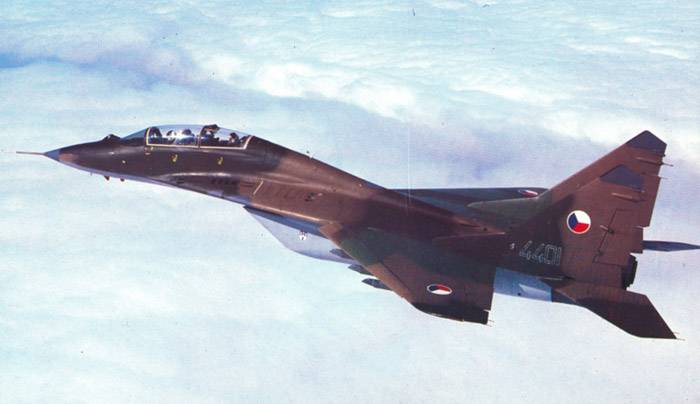
MiG-29 entered service with the 1st fighter aviation regiment, which was deployed in Jatece in the north-west of the Czech Republic, but later they were relocated in Ceske Budejovice in southern Czech Republic, where they armed the 11th fighter aviation regiment. In September 1989, this aircraft unit was declared combat ready. From the very beginning, Czechoslovak single and double MiG-29s carried low-altitude camouflage, which was due to the specifics of the Central European theater of operations.
Section MiG-29 after the collapse of Czechoslovakia
At the end of 1989, as a result of the “Velvet Revolution”, a peaceful dismantling of the communist system took place in the country, and the Czechoslovak Socialist Republic in March 1990 of the year became known as the Czechoslovak Federal Republic. Already in June, 1990, the new Minister of Defense of the CFR announced that the republic was refusing to further purchase combat aircraft in the USSR. Following the "Velvet Revolution" was followed by the "Velvet Divorce", as a result of which 1 January 1993, the united republic was divided into the Czech Republic and Slovakia. According to the agreement, the fighter park was to be divided between the Czech Republic and Slovakia in the proportion of 3: 1.
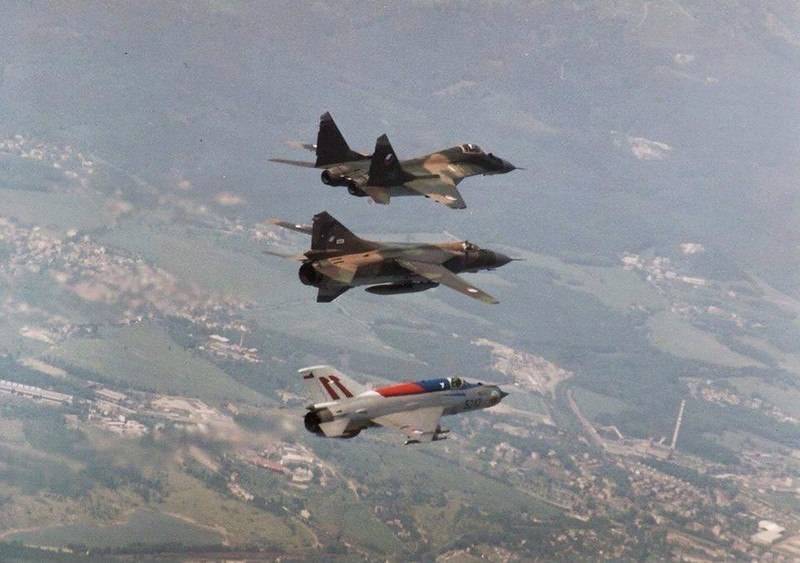
However, the Slovak authorities have abandoned the MiG-23MF / ML fighters due to them. As a result, the Czechoslovak MiG-29А were divided between the Air Force of the newly formed independent states in the proportion 50 / 50: ten - the Czech Republic, ten - Slovakia.
MiG-29 fighter service in the Czech Air Force
In the first years after “Velvet Divorce,” MiG-29 fighters in the Czech Republic were used quite intensively. Thus, from 17 to 23 on June 1994 of the year at the České Budějovice airbase and from 16 to 20 of October 1995, joint French-Czech maneuvers were held at the Čašlav airbase and in which the French Mirage F1 and Mirage 2000 and the MiG-HEXI were involved. -23A. Also, the MiG-29A practiced combat use in the French training ground, located near the town of Mont-de-Marsan. At the beginning of the 29's Western Air Force command was deeply interested in a detailed study of the capabilities of modern Soviet-made fighter jets. Experts from the USA and FRG satisfied their interest by conducting test air battles with MiG-1990А, which belonged to the GDR Air Force, while the French trained on the 29 generation aircraft of the Czech Air Force.
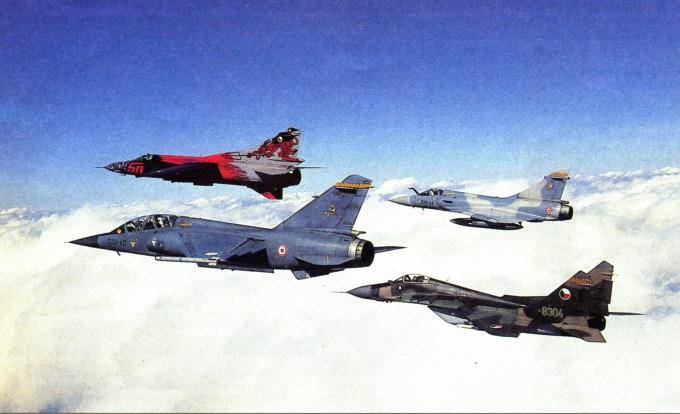
During the joint maneuvering, it turned out that the MiG-29 unconditionally surpasses Mirage F1. The result of the close air combat between the MiG-29 and Mirage 2000 was largely dependent on the qualifications of the pilots. Although the French side was attended by pilots who had a much larger annual raid, they recognized that it was almost impossible to get rid of the MiG, which had landed a Mirage on the tail and was in 500-800 meters from it. At that time, the Czechoslovak air force fighter pilots flew no more than 50 hours per year, and the French who participated in the exercises had more than 200 annual flight hours. For fixing the results of training battles on the MiGs, photo-kinetic guns were used, and on the Mirage cameras were used. The aircraft, subjected to a conditional attack, with the help of the equipment, signaling about the radar exposure, fixed the range and azimuth of its own detection, and the capture of the attacking fighter by the radar. If the Mirage flew lightly, then the MiG-29A was suspended from simulators of short-range missiles UZR-73 with a training recorder, specially designed for testing methods of maneuverable air combat using UR melee P-73.
Already at the beginning of the 1990-x of the Czech Air Force faced a shortage of funding. The deficit of spare parts and consumables, formed after the cessation of military-technical cooperation with Russia, played a negative role in maintaining the MiG-29 in combat status. In March 1994, as a result of the fire, the only Spark of the MiG-29UB and pilots for the single MiG-29А were lost. There was nothing to prepare for. In the second half of 1994, flights of the MiG-29 in the Czech Republic were discontinued, and in 1995, the 9 of the remaining fighters were transferred to Poland in exchange for W-3 Sokół helicopters. It is still not clear what was guided by the Ministry of Defense of the Czech Republic, making the decision to exchange quite modern at that time fighters for improved copies of Soviet Mi-2.
Light combat aircraft L-59 and L-159
The twin combat training aircraft L-59 is a further development variant of the Aero L-39ZА Albatros widespread in ATS air forces and was originally called the L-39MS. His prototype made the first flight of 30 September 1986 of the year. However, the collapse of the "Eastern Bloc" led to the fact that large orders for it did not follow. In order to increase the aircraft's thrust ratio, in the 1995 year, Aero-Vodohody ordered 70 Taiwanese-American engines AIDC F124-GA-100 with 2860 kgf. A total cost of $ 100 million. The FXDUMX-GA-124 TRDDF is a non-modifying modification of the TFE100-1042 engine mounted on Ching-Kuo fighter jets from the Chinese Air Force. This engine combines both acceptable performance and suitable dimensions. Its installation required a minimal revision of the aircraft design. On the outer nodes it was possible to hang a combat load with a mass up to 70 kg. The 1500-mm double-barreled gun GSH-23L with 23 cartridges, 150 UR K-2 or P-13 could be used to combat air targets. The maximum take-off weight of the aircraft reached 60 kg. Practical flight range - 7000 km. Maximum speed - 1500 km / h.
However, despite the more powerful engine and American avionics, the aircraft did not receive much distribution. All were built 70 aircraft L-59. Of these, 60 is shipped to Egypt and Tunisia. An attempt to use the L-59 as a light fighter was frankly unsuccessful. The aircraft, suitable for the role of a light attack aircraft, could not withstand the airborne combat of obsolete generation 3 fighters, not to mention the more modern machines. Even for successful interception of subsonic airplanes flying at low altitude, a fighter with a more powerful engine was required. 5 June 1999 of the year at the SIAD-1999 aviation show in Bratislava, the first public demonstration of the L-159А ALCA light aircraft (Advanced Light Combat Aircraft - a single light combat aircraft) took place. The purpose of the creation of this aircraft was the optimization of the combat capabilities of the Albatross as an attack aircraft and a light subsonic fighter.
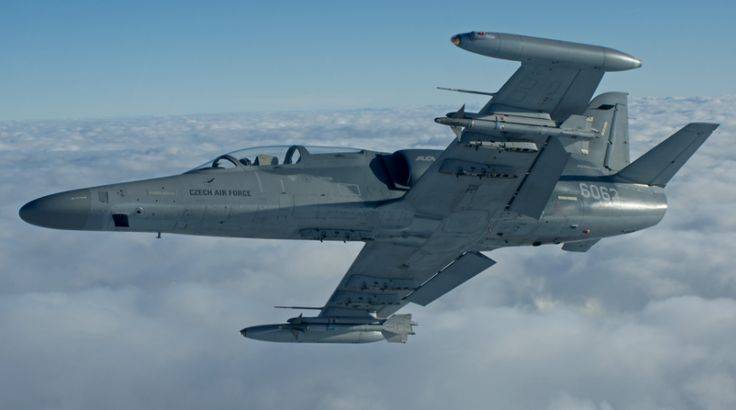
The more powerful F124 Garret engine and crew reduction to one person made it possible to significantly improve flight data compared to the base L-39. The nasal radiotransparent fairing has become much longer and wider. Under it was a mobile elliptical radar antenna Grifo (originally this station was developed under the modernization program of the Singapore F-5E fighter jets of the Singapore Air Force). The maximum speed of the aircraft increased to 936 km / h. On the seven nodes of the suspension, you can place a combat load of 2340 kg. The weight reserves, formed after the liquidation of the second cabin, were aimed at booking the cabin and allowed to increase the fuel supply and, as a result, the combat radius. Thanks to an improved sighting and navigation system, the possibility of using adjustable bombs, AGM-65 Maverick air-to-ground missiles and AIM-9 Sidewinder air combat missiles has appeared.
The first production car entered service with the Czech Air Force 20 October 1999 year. Operation of the drill machines did not reveal any surprises. For pilots, the new aircraft was generally similar to the familiar L-39, and the use of computer diagnostics of onboard systems made life easier for technicians. L-159 has repeatedly taken part in various air shows and NATO exercises. During long flights, there was a congenital deficiency of the aircraft - the absence of an in-flight refueling system, which is why the L-159 pilots did not plan missions for more than two hours. The presence of the radar and the increased speed made it possible to expand the capabilities of the L-159 in the role of low-altitude interceptor. When performing air defense missions, the L-159 is quite suitable for intercepting light aircraft and fighting combat helicopters. The maneuverability characteristics and composition of weapons allow us to hope for success in a defensive air battle with full fighters. But for all its merits, the cost for a light subsonic combat aircraft, despite the increased combat performance, turned out to be excessive, due to the wide use of expensive imported components, engine and electronics of western production. In 2010, the manufacturer asked for it $ 12 million. Considering that at the beginning of 2000's in the world, there were a large number of inexpensive combat training aircraft built in the mid-to-late 80's in the world then potential poor buyers preferred them. The production of single L-159 ended in 2003 year after the construction of 72 aircraft. For a small Czech Republic, such a number of light fighters turned out to be redundant, and no foreign buyers were immediately found. As a result, about 50 built L-159 were unclaimed, and the aircraft went "in storage". Czechs have repeatedly unsuccessfully demonstrated their representatives of Latin American, African and Asian countries. Several planes bought US private aviation companies involved in the provision of services as part of combat training and training for the Air Force and the US Navy. In 2014, they managed to conclude an agreement with Iraq for the supply of 12 L-159. Now in the Czech Air Force, one squadron is equipped with L-159 aircraft.
Despite a certain potential, of course, it is impossible to consider the L-159 a full fighter. Apparently, in Prague, with the abandonment of the MiG-29, it was believed that after the country's accession to NATO, the Czech Republic would not need fighter jets, and it would be possible to save on defense expenditures and make light L-159 subsonic of our own production. But at the headquarters of the block, the Czechs considered the desire to avoid spending on the maintenance of the fighter fleet unreasonable, and pressure was exerted on the country's leadership to acquire modern combat aircraft.
Saab JAS-39 Gripen fighters in the Czech Air Force
Possible applicants included the American F-16C / D and F / A-18E / F, the French Dassault Rafale and the “European” Eurofighter Typhoon. In June, the Czech Air Force 2004 signed a contract with Sweden for the 10 summer rental of 14 Saab JAS 39 Gripen fighters. The contract amount was 19,6 billion kroons (about $ 1 billion), the lease agreement was subsequently extended. The export order was executed at the expense of previously built vehicles destined for the Swedish Air Force. The first six JAS-39 aircraft received 18 on April 2005, the next six JAS-39C - in August 2005. Two double JAS-39D Imported to the base of Caslav at the beginning of September 2005. Aircraft fully comply with NATO standards. The development of JAS-39C / D allowed to finally abandon the operation of the outdated MiG-21МФ.
Fighter JAS-39C Gripen (Batch 3) has a maximum take-off weight of 14000 kg. At the same time he is able to carry a combat load weighing 5300 kg. Maximum speed at high altitude - 2200 km / h. Fighting radius - 800 km. The Swedish fighter is equipped with the PS-0 / 5 Ericsson pulse-Doppler radar, has advanced cabin equipment, a helmet target designation system, and a retractable airborne boom. The fighter’s standard armament includes the 27-mm Mauser BK27 built-in cannon with 120 rounds of ammunition and two short-range guided missiles Rb74IR (Swedish AIM-9L Sidewinder) placed on the wingtips. In total, Gripen can carry 6 Rb74IR or Rb 98 (IRIS-T) melee missiles. On the four suspension nodes, you can hang air-to-air missiles with a semi-active radar homing head Rb.99 (AIM-120 AMRAAM) or Meteor.
The combat potential of fighter aircraft of the Czech Air Force
Currently, the Czech Air Force 211 Tactical Squadron has 14 Gripen (12 JAS-39C and 2 JAS-39D). For actions against low-altitude targets, the 16 L-159A 212 tactical squadron can be used. By the standards of peacetime, three dozen JAS-39C / D and L-159A 211 and 212 squadrons assigned to the Caslav airbase are considered to be quite enough to control the airspace, patrol and prevent the intrusion of intruders. However, Czech flights JAS-39C / D is not limited to its territory. As part of the "police air patrol", Czech Air Force fighters in 2009 and 2013 deployed at the Lithuanian Siauliai airbase. 4 airbases with corresponding infrastructure can be used as backup bases for two Czech fighter squadrons.
Assessing the current state of the Czech Air Force, it can be stated that the potential of combat aviation, despite being equipped with fairly modern Swedish-made fighter jets, has decreased several times compared to the start of the 1990's, and now Czech fighter squadrons actually play a decorative and demonstration role.
Fighter aircraft of Slovakia after "Velvet Divorce"
The authorities of Slovakia reacted to the socialist legacy more carefully. In 1993, 229 aircraft entered the newly formed air force. The 36 MiG-21MP, 11 MiG-21UM, 9 MiG-29А and 1 MiG-29UB could be used to intercept and gain air superiority. After the division of the Czech Republic and Slovakia during the formation of the national armed forces, Slovak fighters, anti-aircraft missile forces and radio engineering units were merged into the 3-e command (corps) of the Air Force and Air Defense.
In December 1993 of the year, an agreement was reached on the delivery of single-seat MiG-12 and 29 “Sparks” MiG-2UB to the account of the Russian 29 debt. In 1995, for the first time in stories The Slovak Air Force fighters of the MiG-21МФ and MiG-29А 31-th wing, deployed at the Sliac airbase, took part in the shooting at the Polish Ustka training ground. At the same time, the K-13 and P-60 missiles were launched. As targets were used 250 kg lighting bombs, hovering on a parachute.
MiG-29 service in the Slovak Air Force
For a country like Slovakia, it was very burdensome to maintain, in the face of a decrease in international tension, a significant aviation fleet of military aircraft. Inadequate funding led to the fact that in the 1999 year, only three MiG-29s were able to maintain in the flying state. The main reason for setting Slovak "Fulcrum" to joke was the lack of consumables and spare parts. Under these conditions, the combat readiness of the available MiG-21МФ, whose age at that time exceeded 20 years, was even higher. For these “veterans of the cold war” consumables and spare engines were accumulated in sufficient quantities. In case of urgent need there was an opportunity to agree on repairing the MiG-21 in the Czech Republic. However, due to the shortage of aviation kerosene, even combat-ready aircraft were chained to the ground, and the annual raid of Slovak fighter pilots was 15-20 hours. At the end of 1990, the situation in Slovakia very much resembled the one that developed in the Russian air force.
At that time, against the background of the NATO accession negotiations in Bratislava, they seriously considered abandoning fighter aviation altogether, especially since at the beginning of the 21 of the 20th century there was a surge in accidents in the Slovak Air Force, largely due to the low qualifications of pilots. The loudest flight incident was the crash that occurred on 7 on November 2002, when two MiG-29s collided during the night flight. One pilot successfully ejected, and the other died. In 2003, the Slovak Air Force experienced an acute shortage of fighters capable of taking to the air to intercept violators of the state border. Due to the poor technical condition and the development of the life of the main units, several MiG-29s could be lifted into the air, and all of the MiG-21s were removed from service in order to save. By that time, it became clear that in order to preserve the existing fighter fleet, the remaining MiG-29 need to be repaired and modernized. Otherwise, all Slovak MiGs would have been written off by 2020.
Modernization of the Slovak MiG-29
The first reports on the intention of Bratislava to modernize the existing MiG-29 appeared in the 2002 year. November 24 2004 Slovakia signed a contract with RAC "MiG" for the modernization of ten MiG-29А and two MiG-29UB. This contract created a precedent in cooperation between Russia and Western companies in the field of modernizing Russian-made aircraft that are in service with a NATO country. The total cost of the modernization program was $ 74,2 million. Of this amount, the Russian side received $ 43 million. Modernization of the MiG-29 and the extension of their service life were carried out at the aircraft repair plant in Trencin, which serves the entire fleet of Slovak Air Forces. Works were completed at the end of the year 2007. The first upgraded MiG-29AS (onboard number 6728) took off from the Trencin 1 airfield in December 2005.
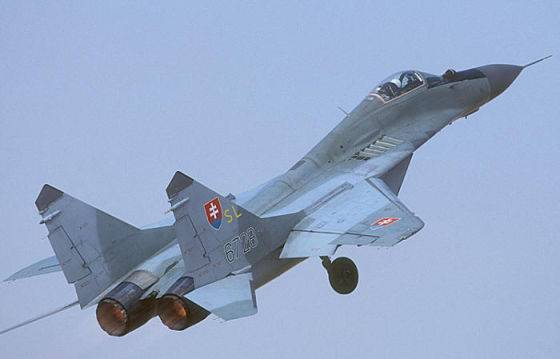
According to RSK MiG, the Slovak Air Force, subject to proper maintenance, will be able to operate the MiG-29AS until the 2030 of the year. Not modernized aircraft that have developed a resource, were put into storage. In 2008, Slovak fighters received digital camouflage.
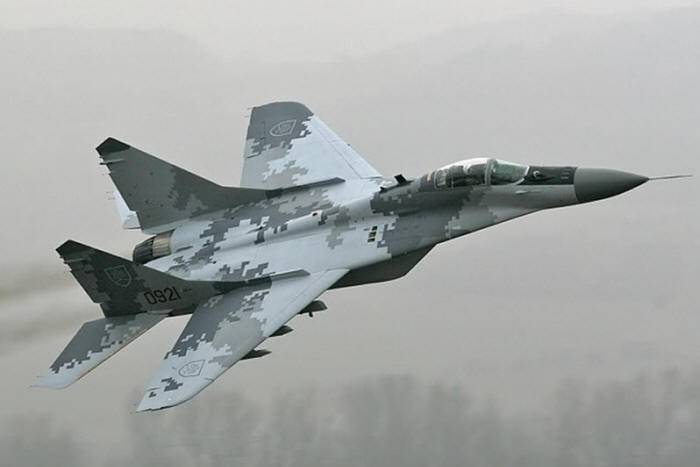
Since the MiG-29AS had to meet the standards of NATO and ICAO, the radio equipment, navigation systems, and also the state recognition equipment of the Slovak fighters were replaced with Western models. Most of the work associated with the replacement of avionics, performed by the Slovak Aviation Technical Center. MiG-29AS were equipped with American radio stations Rockwell Collins AN / ARC-210 (V). Since the transmitter of the radio station has a characteristic antenna mounted on top of the fuselage behind the cockpit, the upgraded fighters can be distinguished by this feature. Other equipment manufactured by Rockwell Collins was the tactical navigation system AN / ARN-153 (V), as well as the integrated radionavigation system of the aeronautical equipment for the AN / ARN-147 (V) aircraft. The British concern BAE Systems has put the digital state recognition system AN / APX-113 Mk. XII (V). In the cockpit, four Russian-made LCD monitors, two multifunctional MFI-54 indicators and a PU-29 control panel were mounted. As part of the modernization program, the outdated LTV-29 simulator was upgraded to the LTV-29M level, which made it possible to reflect the installation of new equipment on aircraft. Also, upgraded fighters received new digital graphics systems and improved maps that covered a large surface area. Instead of dial gauges, graded in the metric system, devices are installed that display miles, feet, and pounds. It is stated that the upgraded MiG-29AS of the Slovak Air Force meets the requirements of ICAO and is able to participate without any restrictions in NATO operations. The system of state recognition makes it possible to classify targets without referring to ground control centers. Entering into the onboard equipment navigation receivers and multi-indicator allows you to display the navigation-planned situation with reference to the current position of the aircraft.
The current state of the fighter fleet of the Slovak Air Force and development prospects
The upgraded MiG-29AS Slovak air force flew actively until 2017, and repeatedly participated in joint NATO air force exercises. However, budgetary constraints and the need for routine repairs affected the fighter’s technical readiness ratio. According to the information published in the Slovak media, currently 12-29-5-6 is in combat readiness from 2014 MiG-29AS / UBS, and more than half of the Air Force’s budget is spent on their content. As a temporary measure in 29, an agreement was signed with RSK MiG on a five-year maintenance and repair program for the MiG-39. According to the available information, negotiations on the overhaul of the existing MiGs ended in vain. Apparently, the further exploitation of the MiG-4 was under threat due to the anti-Russian position of the Slovak leadership. Instead of a major overhaul of Russian-made fighters, the Slovaks preferred to acquire new fighters. Initially, Bratislava was inclined to rent a Swedish JAS-2018 Gripen. However, due to legal disputes with the Swedes, the leadership of Slovakia turned to the United States. 14 April 16 The US Department of Foreign Affairs and the Defense Security Agency approved the sale of the X-NUMX F-70V Block 72 / 16 light fighters. This is currently the most advanced version of the F-35. The fighter of these modifications is installed avionics, used on the F-22 Lightning II and F-2022 Raptor. According to the plans, the Slovak Air Force will receive the first aircraft in the last quarter of 2023, and all the fighters will deliver to the customer by the end of 12. In total, the Air Force will receive 16 single-seater F-70V Block 16 and two double-seat fighter F-72V Block XNUMX. The aircraft are fully compatible with NATO systems and are equipped with modern equipment.
According to the country's defense minister, Peter Gaidosh, Bratislava preferred American fighters instead of Swedish JAS-39, as they are more modern and technologically more advanced. In addition, military-technical cooperation with the United States for Slovakia is more preferable for political reasons. Slovakia's Prime Minister Peter Pellegrini, stressing the importance of the signed contracts, announced the cost of the contract: more than € 1,6 billion. The agreement also provides for comprehensive training for 22 pilots and 160 technical specialists, two-year logistic support since the start of operation of the aircraft in Slovakia. The purchase of American fighters is one of the testimonies of Slovakia’s commitment to fulfilling its commitments to NATO to increase defense spending to 2% of GDP.
At the same time, Slovakia, in case of refusal of an agreement to extend the operation of the MiG-29 before the start of deliveries of F-16V, risks remaining without fighters at all, since the current agreement expires in the fall of the 2019 year. According to the latest information, the Slovak Ministry of Defense intends to extend the contract with Russia. Depending on the requested services, the cost of the new agreement with RSK MiG varies from € 20 to 50 million.
At the moment, the Slovak Air Force has three air bases. But all combat-ready Slovak fighters of the Tactical wing named after Major General Otto Smica are based at the Sliac airbase, in the central part of the country.
In addition to the 10 MiG-29AS and 2 MiG-29UBS, the wing has 5 training and combat L-39CM and 2 L-39ZAM, which can also be used to intercept low-altitude and low-speed air targets. In the past few years, the annual raid of Slovak pilots has been about 90 hours (NATO standards provide for 120 to 180 hours). According to the views of the Slovak Air Force Command, at least 15 modern fighters should be in the ranks to effectively protect the airspace and fulfill NATO commitments. By 2030, Slovakia intends to spend on modernization of the armed forces about €, 6,5 billion, about half of these funds will be spent on upgrading the air force and air defense systems.
To be continued ...
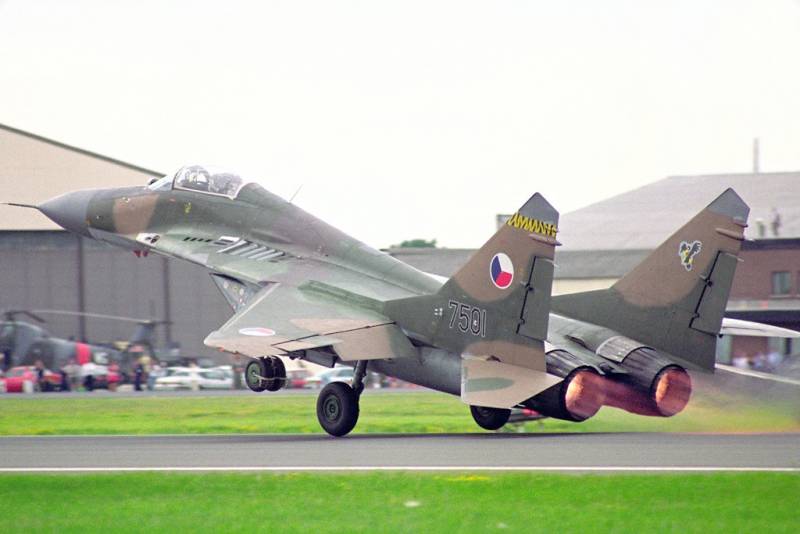
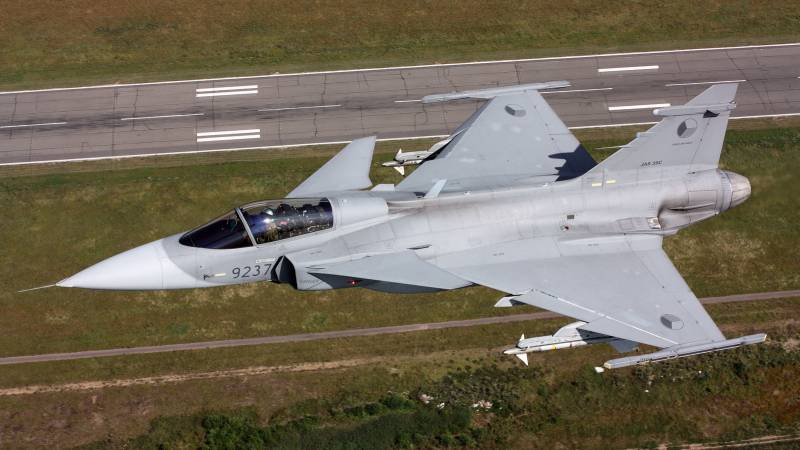
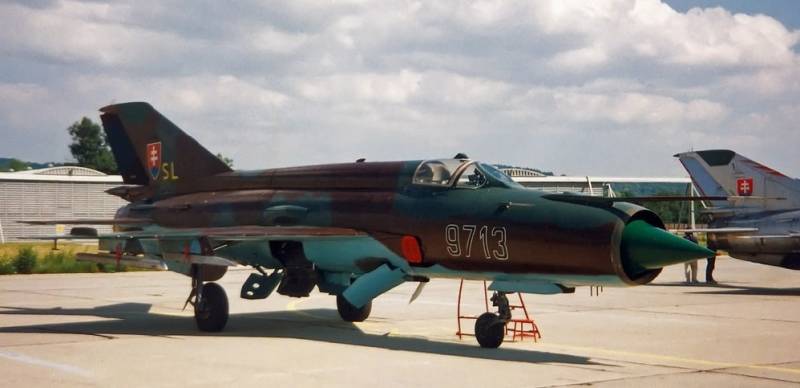
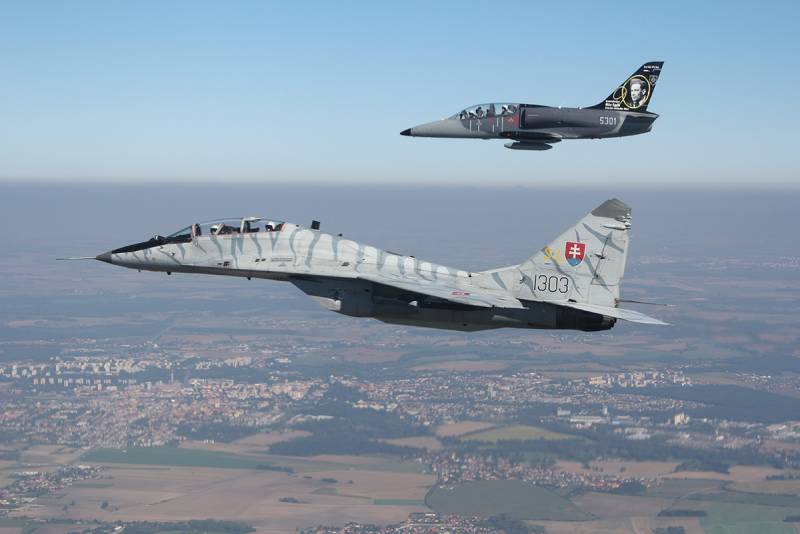
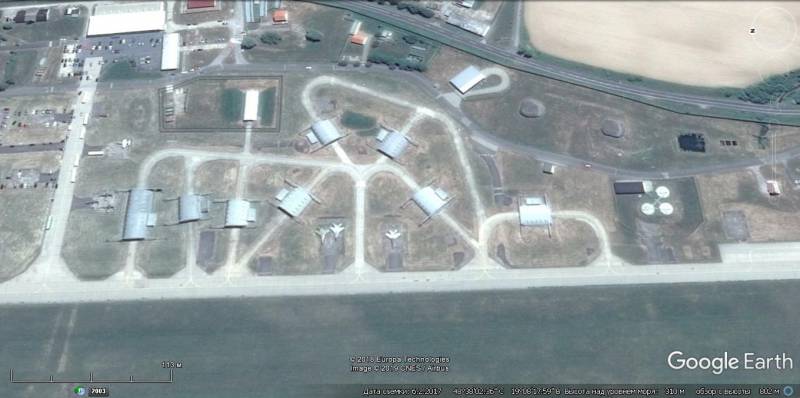
Information